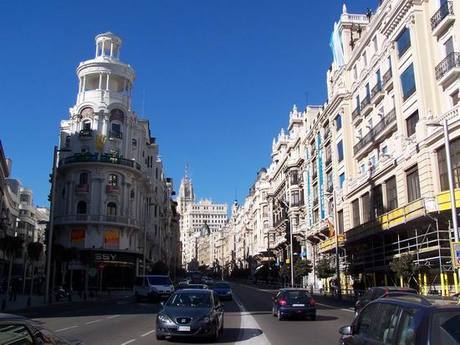Gran Vía
The Gran Vía, together with the Paseo de la Castellano, is Madrid's most famous street, mentioned in zarzuelas (Spanish operettas) and books and shown many times in films.
It starts at the Plaza de Alcalá square and leads across the city to the expansive Plaza de España. Along this Great Way, as its name translates, there are hundreds of businesses - shops, stores, hotels, banks, restaurants, bars, cinemas and theatres - making this perhaps one of the most important commercial districts in the city.
In the mid 19th century, Madrid's urban planners decided that a new thoroughfare had to be created, connecting the Calle de Alcalá with the Plaza de España. The project required many buildings in the center of the city to be demolished, earning it the name of 'an axe blow on the map'. Decades after the first plans were made, construction still hadn't started and the media ridiculed the project, cynically calling it the 'Gran Vía' or 'Great Road'. Finally in 1904 it was approved and construction started a couple of years later. The last part of the street was completed in 1929.
The new road created opportunities for architects, who had the ability to create large buildings in the latest architectural styles. The first eye catching building starting from the Calle de Alcalá is the most famous of all, the Edificio Metrópolis or Metropolis Building. The landmark was built between 1907 and 1911 after a design by the architects Jules & Raymond Février. The original statue was replaced in 1975 by a statue of a winged Goddess Victory.
The Gran Vía of Madrid has many historical names, both official and unofficial. Conception divided the Road in three parts. The first one was built between 1910 and 1917 and was called Calle del Conde de Peñalver ("Count of Peñalver Street"). Second part of the project started on 1917 and was ended on 1921. It was named Calle de Pi y Margall ("Francisco Pi y Margall Street") after a deceased politician. The third part of the road, and the last one, did not start until 1925 and was called Calle Eduardo Dato Iradier ("Eduardo Dato Street") after another politician.
Three months before the Spanish Civil War began, the Second Spanish Republic changed some street names under leftist influence. The two first parts of the avenue were called Avenida de la C.N.T. ("C.N.T. Avenue"). When the Civil War started, the avenue was renamed Avenida de Rusia ("Russia Avenue") due to the support of this country for the Spanish Republic, but soon its name would be changed to Avenida de la Unión Soviética ("Soviet Union Avenue"). However, the avenue was popularly nicknamed as Avenida de los obuses ("howitzer avenue") because of the continued bombardments by the Nationalist forces loyal to Francisco Franco. The reason for these attacks in this area was that the "Edificio de Telefónica" (the Spanish phone company) is in this street.
Just after the end of the war when the rebels entered Madrid they changed the name of the road and renamed it Avenida de José Antonio ("José Antonio Avenue") after one of their greatest political figures, founder of the fascist party, Falange. It wouldn't be until 1981, under Spain democracy when the socialist mayor restored the names of 27 streets and the avenue was simply named Gran Vía ("Great Road").
A bit further along the Gran Vía, on the left hand side is another landmark, the Edificio Grassy, another corner building with a small tower, built in 1917. Visible from here is the tower of the Telefónica Building, the first European skyscraper built between 1926 and 1929 for the Spanish telecommunications company. The 88-meter (290 ft) building was the tallest in Madrid and was designed by an American, Louis S. Weeks.
The street, and even its different sections, has had several different names over the years, changing most frequently in the years leading up to and during the Civil War. The dictator Franco gave it its most enduring name of Avenida de José Antonio in remembrance of the founder of the Falange party.
The definitive name of Gran Vía was given, democracy re-established, in 1981 by the then Lord Mayor, Enrique Tierno Galván (said to be Madrid's most loved Mayor). This name harks back to how the locals originally visualized and named the project back in the 19th century, as the Great Way across the city.
There are several important and interesting buildings located along the street, including the Edificio Metrópolis at the corner of Calle Alcalá and Gran Via - its grand columns holding decorative statues - and the Telefónica building at number 28 which is 88 meters tall and was Madrid's tallest skyscraper until 1953.
It is always interesting to walk along the street and look to the rooftops of these impressive buildings, since many of them are lavishly decorated and often possess large statues, sometimes precariously perching on the ledge of the roof. You can get there via flight to Madrid.




